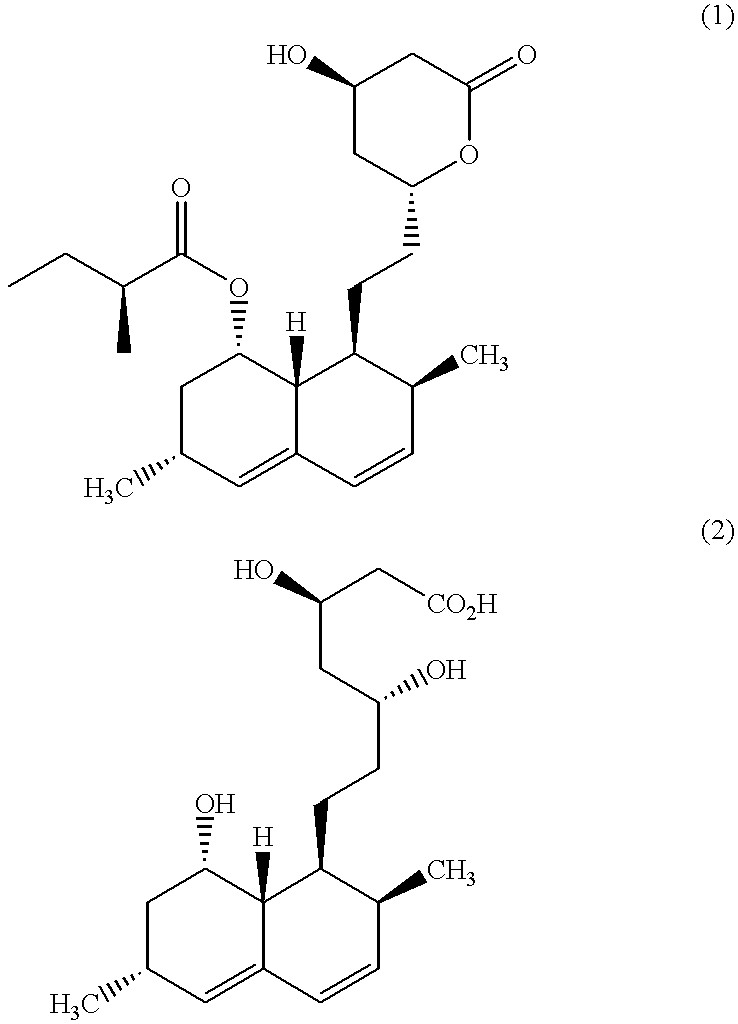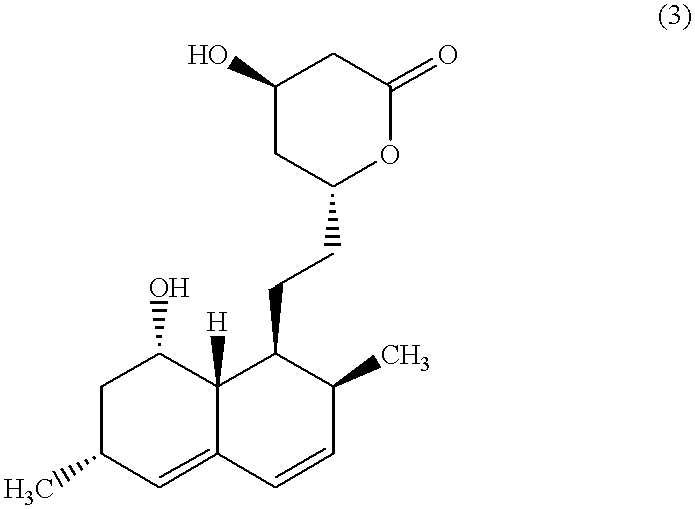Process for producing simvastatin
a technology of simvastatin and process, which is applied in the field of process for producing simvastatin, can solve the problems of complex purification procedure, low yield and productivity, and low yield and productivity, and achieve the effect of high efficiency
- Summary
- Abstract
- Description
- Claims
- Application Information
AI Technical Summary
Benefits of technology
Problems solved by technology
Method used
Image
Examples
example 1
Process for Producing the Diol Lactone (compound of the formula (3))
To a solution of KOH (7.92 g) in 300 ml of t-butyl alcohol was added 8.09 g (20 mmol) of lovastatin, and the mixture was stirred under argon gas at room temperature for 30 minutes. Then, the temperature was raised and the mixture was refluxed with stirring for 4 hours. This reaction mixture was concentrated under reduced pressure, added with water, acidified with phosphoric acid (pH=3.5), and extracted with ethyl acetate. The extract was concentrated under reduced pressure to give a brown-colored oil. This brown-colored oil was dissolved in 200 ml of isopropyl acetate, and after addition of 65 .mu.l (1 mmol) of methanesulfonic acid, the solution was concentrated to about 1 / 5 volume under reduced pressure. The residue was washed with saturated aqueous solution of sodium hydrogencarbonate, cooled to -20.degree. C., and stirred. The resulting slurry was filtered and dried in vacuo to give white crystals. This product w...
example 2
Process for Producing 2,2-dimethyl-6 (R)-(2-(8-(S)-hydroxy-2(S),6(R)-dimethyl-1,2,6,7,8,8a(R)-hexahydronaphthyl -1(S))ethyl)-4(R)-(methyloxy-carbonyl)methyl-1,3-dioxane (compound of the formula (4))
To a solution of the diol lactone (1.62 g, 5 mmol) in 25 ml of methylene chloride were added 3,69 ml (30 mmol) of 2, 2-dimethoxypropane and 48 mg (0.25 mmol) of p-toluenesulf onic acid, and the mixture was stirred under argon gas at room temperature for 1 hour. This reaction mixture was neutralized with pyridine and concentrated under reduced pressure, and the concentrate was purified by silica gel column chromatography to give a clear oil. This product was identified to be the title compound.
NMR(CDCl.sub.3, 400 MHz) .delta.: 0.89 (d, 3H), 1.1-1.9 (m, 16H), 1.2 (d, 3H), 2.2-2.6 (m, 5H), 3.65 (s, 3H), 3.85 (m, 1H), 4.2 (m, 1H), 4.3 (m, 1H), 5.5 (bt, 1H), 5.78 (dd, 1H), 6.0 (d, 1H).
example 3
Process for Producing 2,2-dimethyl-6(R)-(2-(8(S)-(2,2-dimethylbutyryloxy)-2(S),6(R)-dimethyl-1,2 ,6,7,8,8a(R)-hexahydronaphthyl-1(S))ethyl)-4(R)-(methyloxycarbonyl)methyl-1 ,3-dioxane (compound of the formula (5))
To a solution of 2,2-dimethyl-6(R)-(2-(8-(S)-hydroxy-2(S),6(R)-dimethyl-1,2,6,7,8,8a(R)-hex ahydronaphthyl-1(S))ethyl)-4(R)-(methyloxycarbonyl)methyl-1,3-dioxane (1.96 g, 5 mmol) in 16.2 ml (40 mmol) of pyridine were added 122 mg (1 mmol) of 4-dimethylaminopyridine and 2. 69 g (20 mmol) of 2,2-dimethylbutyryl chloride, and the mixture was stirred at 100.degree. C. for 6 hours. This reaction mixture was concentrated under reduced pressure and added with ethyl acetate. The organic layer was washed with 10% aqueous solution of citric acid and concentrated under reduced pressure. The residue was purified by silica gel column chromatography to give a clear oil. This product was identified to be the title compound.
NMR (CDCl.sub.3, 400 MHz) .delta.: 0.88 (t, 3H), 0.89 (d, 3H), 1.0...
PUM
| Property | Measurement | Unit |
|---|---|---|
| Time | aaaaa | aaaaa |
| Angle | aaaaa | aaaaa |
| Angle | aaaaa | aaaaa |
Abstract
Description
Claims
Application Information
 Login to View More
Login to View More - R&D
- Intellectual Property
- Life Sciences
- Materials
- Tech Scout
- Unparalleled Data Quality
- Higher Quality Content
- 60% Fewer Hallucinations
Browse by: Latest US Patents, China's latest patents, Technical Efficacy Thesaurus, Application Domain, Technology Topic, Popular Technical Reports.
© 2025 PatSnap. All rights reserved.Legal|Privacy policy|Modern Slavery Act Transparency Statement|Sitemap|About US| Contact US: help@patsnap.com



